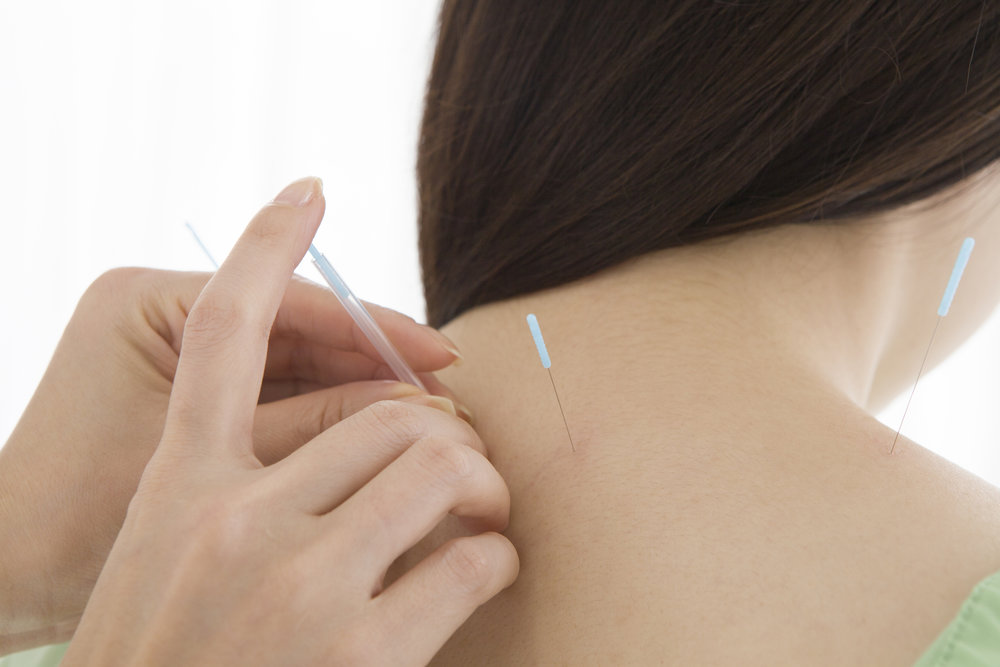
Needling
Extremely fine needles (a hair's breadth) are inserted at points on a patient's body specific to treatment protocols. A guide tube containing the needle is placed on the point to be needled. The needle is then gently tapped in and inserted. When the Qi (energy) in the Channel reaches the needle (called deqi) the patient should feel a pulling/tight or heavy sensation at the point of insertion and regularly might feel energy flow in the area or limb treated. Duration of treatment can take from a simple in and out to leaving the needles in for between 15-20 minutes and occasionally longer.
All needles are single use and sterile.
Cupping
I use a flame to create a partial vacuum in the cups which are then carefully placed on the skin. Because of the vacuum in the cup the blood is drawn to the surface of the skin in the areas that require treatment. The sensation of the suction drawing the tissue into the cup feels like a deep tissue massage.
Cupping is applied in cases of :
- Common colds, coughs and flu
- Chronic bronchitis and asthma
- Muscular pain and tension
- Arthritis
- Lower backache
- Frozen shoulder
- Tennis elbow
- Digestive weakness
- Irregular menstruation and dysmenorrhea.
for Relief from Respiratory Issues
A combination of acupuncture and cupping therapy treats disease associated with the lungs including seasonal allergies, chronic year-round allergies, colds, flus, any cough including those from bronchitis and pneumonia, and COPD.
Cupping helps to stimulate the immune system to focus on the lungs and upper respiratory tract. This means the immune system sends aid to the area to clean up the cold and flu virus or bacterial invaders. Getting cupping early in a cold or flu, may cause you to spike a fever for 24 hours. This is a sign that the immune system is active.
Cupping also will help break up phlegm in your lungs, which will allow you to cough it out. This is especially useful if you feel any congestion in your chest. Ever had a cold where it felt like you had some phlegm that needed to come out, but you just couldn’t cough it up? Cupping will help with this.
Can cupping be preventative for colds and flus?
Cupping therapy can help keep your immune system in good shape if done regularly during the autumn and winter cold and flu season. This will make you less likely to get ill. In other words if you keep your immune system strong being exposed to a cold or the flu should not necessarily mean you should get ill with it.
Regular cupping therapy can help give you added protection against getting ill if you work in an environment where you regularly get exposed to colds and flu.
Cupping to treat traumatic injury and restart healing processes
Cupping targets deep tissues by creating suction and as such the area traumatized receives a fresh infusion of blood (nutrients and oxygen) that work to heal the damage done by injury. In addition, the blood carries away the accumulation of toxins, dead cells, and other debris that may be hampering healing and causing pain. As a result of better blood circulation, the tensed muscles and stiff tissues relax. Not only is discomfort alleviated but patients also sense relaxation that helps lower stress levels.
Western medicine however often recommends medication and treatments such as icing the area to reduce the swelling, however utilizing ice causes further blood stasis and ends up stopping the healing process before it is complete. Cupping works therefore to cause inflammation in the tissues by drawing blood to them and by doing so restarting the natural healing process.
Cupping to help eliminate waste
Cupping can help remove toxins from the body and stimulate the flow of fresh blood, lymph, and Qi to the affected area and throughout the body. An accumulation of toxins causes the body to be more susceptible to infection and disease. Cupping therapy can help by aiding the toxins, dead cells, and other metabolic waste move to the lymphatic system so the body eliminates them naturally. To help the movement of waste out of your body, I recommend that you drink lots of water after a cupping session.
Cupping to relax muscle tension
Relaxing muscle tension due to emotional stress, when the shoulders and back are often too tender for massage.
Cupping to treat appearance of the skin
By improving blood circulation, cupping therapy can improve the appearance of the skin. That’s because the suction has the effect of promoting the rejuvenation of the layer of collagen and elastin under the skin. When this layer produces more cells and plumps up, the skin also looks and feels better. Any kind of skin conditions including diseases like herpes, eczema, the orange-peel effect caused by cellulite, and acne scars may be treated with cupping therapy.
Cupping to relieve stress and anxiety
Cupping therapy gives you the same effects of a deep tissue massage but by way of reverse pressure. As your tensed muscles relax because of the improved blood flow, you’ll sense relief from the stress and anxiety.
When the blocked energy in your body starts to flow more freely, you feel a deep sense of relaxation and well-being as the nervous system is sedated and calmed.
Cupping for Better Digestion
When cupping therapy is performed on the abdomen, it works to release the stress and stiffness in the muscles. As the tissues relax, better movement is induced in the working of the digestive system.
Any issues you had such as chronic stomach pain, diarrhea, constipation, fluid retention, Irritable Bowel Syndrome (IBS), loss of appetite, flatulence, and other gastrointestinal diseases can be treated with the help of cupping therapy. Given that gastric disease is often linked to stress and anxiety, cupping therapy may be the perfect answer these issues.
Moxibustion
Moxibustion is a traditional Chinese medicine technique that involves the burning of mugwort leaves (Artemisia vulgaris) a small, spongy herb, to facilitate healing. Moxibustion has been used throughout Asia for thousands of years; in fact, the actual Chinese character for acupuncture, translated literally, means "acupuncture-moxibustion."
The purpose of moxibustion is to strengthen the blood and stimulate the flow of Qi by warming the Channels and expelling Cold. Patients receiving moxibustion often report a sudden flooding of warmth that quickly radiates along a specific pathway (usually corresponding with the jing luo channel that is being treated) away from the site of application. This is a good result as it indicates the arrival of the blood and Qi (energy) to the area.
I often practice both acupuncture and moxibustion in the same session when appropriate to the diagnosis and treatment to enhance treatment outcome.
Direct moxibustion
A tiny, cone-shaped amount of moxa is placed on top of an acupuncture point, burned and removed before it burns the skin. The patient experiences a pleasant heating sensation that penetrates deep into the skin
Indirect moxibustion
The practitioner lights one end of a moxa stick, roughly the shape and size of a cigar, and holds it close to the area being treated. The glowing end of the moxa stick is held about an inch or two above the surface of the skin until the area reddens and becomes suffused with warmth.
Moxa on a needle
A needle is inserted into the point being treated and retained and moxa is burned at the end of the needle which causes the heat to penetrate deep into the area. After the desired effect is achieved, the moxa is extinguished and the needle removed.
The application of moxa is extremely wide ranging .
Moxibustion is applied in cases of :
- Protection against cold and flu strains
- Pain due to injury or arthritis, especially in Cold patterns where the pain naturally feels better with the application of heat
- Digestive disorders and irregular elimination
- Period pain and other gynecological and obstetrical conditions. Recent research has shown that moxa can increase blood circulation to the pelvic area and uterus. This could explain its use in treating breech births and menstrual cramps.
- Lower backache due to Kidney Yang xu and blood stasis
- Infertility due to Kidney-Yang xu and a Cold uterus.
- Diarrhea
- Poor digestion
- Stroke sequelae
- Tiredness
·
Tui Na
(Chinese medical massage)
Tui na differs from other forms of massage in that it is used to treat specific stresses of an internal nature as well as muscular skeletal ailments. It is both a form of physical bodywork and a subtle energy medicine. As a physical therapy it excels at releasing the channel sinews, (collectively the muscles, tendons and ligaments) and facilitating the movement of joints.
By opening, releasing and balancing the channel sinews, Tui na is able to treat not only muscular skeletal problems, but also any ailment that may be caused by emotional and postural holding patterns that have become unconscious and locked into the body’s protective connective tissue armour.
As a form of energy medicine I utilize and direct Qi through my hands into points, along channels and into the Organs (Zangfu) and bones. Depending on my patient’s presentation and requirements I practice Tui na in a vigourous and physically active way or in a way that is subtle and still.
Tui na has the ability to :
- Improve and regulate the functions of the internal organs
- Release and relax the channel sinews
- Lubricate and facilitate the movement of joints
- Expel, clear, dissipate and dredge pathogens from the body
- Build resilience to disease.
- Promote and invigorate the flow of Qi (energy) and Blood
- Nourish and strengthen Qi, Blood and constitutional energy
- Sooth and calm the spirit.
The Benefits of Tui Na
Tui na can help with many conditions, acute or chronic:
- Shoulder and neck pain
- Sports injuries
- Repetitive Strain Injury
- Fatigue and Stress
- Cold hands and/or feet
- Headaches and Migraine
- Insomnia
- Rheumatism, Arthritis
- Digestive Disorders
- Increase circulation of blood and lymph removal of waste products
- Removal of scar tissue
- Increase muscle tone
- Relaxation
Gua Sha
Gua Sha is a highly effective therapy to use in conjunction with acupuncture and tui na. ‘Gua’ means to scrape and ‘sha’ is a red skin rash. The rash is intentionally brought to the surface by scraping the lubricated skin surface with a rounded and smooth tool This sounds worse than it actually is; it is in fact painless when done correctly and patients often find it very relieving, as it is so effective for easing pain and stiffness.
Gua sha affects the Exterior of the body and channel sinews. It has been used in many countries as part of folk medicine for treating common ailments such as fever, common colds, aches and pains. Towards the end of the last century it was developed and used by practitioners of Chinese medicine both as a diagnostic method and for the treatment of painful conditions such as arthritis.
Gua Sha is used in treatment of :
- Any acute or chronic pain, stiffness and immobility
- Sunstroke
- Fever
- Colds and flu
- Bronchitis, asthma and emphysema
- Headaches and migraine
- Hypertension



